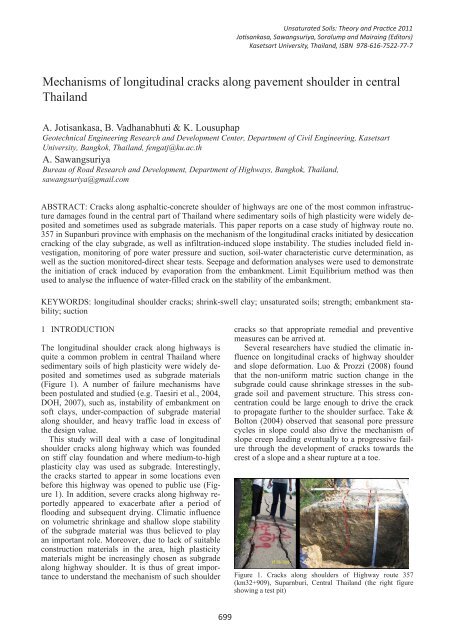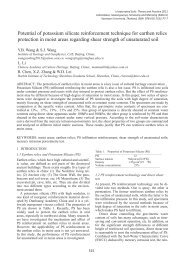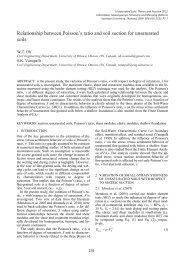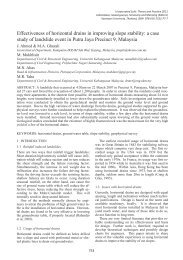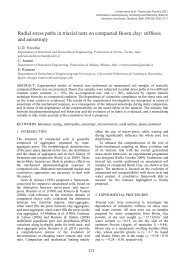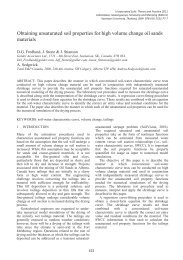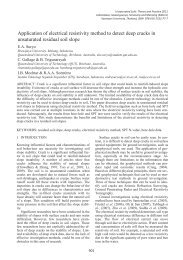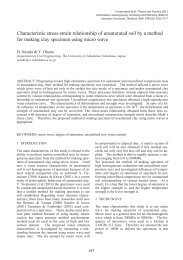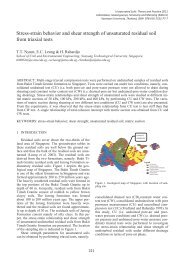Mechanisms of longitudinal cracks along pavement shoulder in ...
Mechanisms of longitudinal cracks along pavement shoulder in ...
Mechanisms of longitudinal cracks along pavement shoulder in ...
- No tags were found...
Create successful ePaper yourself
Turn your PDF publications into a flip-book with our unique Google optimized e-Paper software.
Unsaturated Soils: Theory and Practice 2011Jotisankasa, Sawangsuriya, Soralump and Maira<strong>in</strong>g (Editors)Kasetsart University, Thailand, ISBN 978-616-7522-77-7<strong>Mechanisms</strong> <strong>of</strong> <strong>longitud<strong>in</strong>al</strong> <strong>cracks</strong> <strong>along</strong> <strong>pavement</strong> <strong>shoulder</strong> <strong>in</strong> centralThailand <strong>Mechanisms</strong> <strong>of</strong> <strong>longitud<strong>in</strong>al</strong> <strong>cracks</strong> <strong>along</strong> <strong>pavement</strong> <strong>shoulder</strong> <strong>in</strong> centralThailandAp<strong>in</strong>iti Jotisankasa, Barames Vadhanabhuti & Krit LousuphapGeotechnical Eng<strong>in</strong>eer<strong>in</strong>g Research and Development Center, Department <strong>of</strong> Civil Eng<strong>in</strong>eer<strong>in</strong>g, KasetsartUniversity, Bangkok, Thailand, fengatj@ku.ac.thA. Jotisankasa, B. Vadhanabhuti & K. LousuphapAuckpath Geotechnical SawangsuriyaEng<strong>in</strong>eer<strong>in</strong>g Research and Development Center, Department <strong>of</strong> Civil Eng<strong>in</strong>eer<strong>in</strong>g, KasetsartBureau University, <strong>of</strong> Bangkok, Road Thailand, Research fengatj@ku.ac.thand Development, Department <strong>of</strong> Highways, Bangkok, Thailand,sawangsuriya@gmail.comA. SawangsuriyaBureau <strong>of</strong> Road Research and Development, Department <strong>of</strong> Highways, Bangkok, Thailand,sawangsuriya@gmail.comABSTRACT: Cracks <strong>along</strong> asphaltic-concrete <strong>shoulder</strong> <strong>of</strong> highways are one <strong>of</strong> the most common <strong>in</strong>frastructuredamages found <strong>in</strong> the central part <strong>of</strong> Thailand where sedimentary soils <strong>of</strong> high plasticity were widely depositedand sometimes used as subgrade materials. This paper reports on a case study <strong>of</strong> highway route no.357 <strong>in</strong> Supanburi prov<strong>in</strong>ce with emphasis on the mechanism <strong>of</strong> the <strong>longitud<strong>in</strong>al</strong> <strong>cracks</strong> <strong>in</strong>itiated by desiccationcrack<strong>in</strong>g <strong>of</strong> the clay subgrade, as well as <strong>in</strong>filtration-<strong>in</strong>duced slope <strong>in</strong>stability. The studies <strong>in</strong>cluded field <strong>in</strong>vestigation,monitor<strong>in</strong>g <strong>of</strong> pore water pressure and suction, soil-water characteristic curve determ<strong>in</strong>ation, aswell as the suction monitored-direct shear tests. Seepage and deformation analyses were used to demonstratethe <strong>in</strong>itiation <strong>of</strong> crack <strong>in</strong>duced by evaporation from the embankment. Limit Equilibrium method was thenused to analyse the <strong>in</strong>fluence <strong>of</strong> water-filled crack on the stability <strong>of</strong> the embankment.KEYWORDS: <strong>longitud<strong>in</strong>al</strong> <strong>shoulder</strong> <strong>cracks</strong>; shr<strong>in</strong>k-swell clay; unsaturated soils; strength; embankment stability;suction1 INTRODUCTIONThe <strong>longitud<strong>in</strong>al</strong> <strong>shoulder</strong> crack <strong>along</strong> highways isquite a common problem <strong>in</strong> central Thailand wheresedimentary soils <strong>of</strong> high plasticity were widely depositedand sometimes used as subgrade materials(Figure 1). A number <strong>of</strong> failure mechanisms havebeen postulated and studied (e.g. Taesiri et al., 2004,DOH, 2007), such as, <strong>in</strong>stability <strong>of</strong> embankment ons<strong>of</strong>t clays, under-compaction <strong>of</strong> subgrade material<strong>along</strong> <strong>shoulder</strong>, and heavy traffic load <strong>in</strong> excess <strong>of</strong>the design value.This study will deal with a case <strong>of</strong> <strong>longitud<strong>in</strong>al</strong><strong>shoulder</strong> <strong>cracks</strong> <strong>along</strong> highway which was foundedon stiff clay foundation and where medium-to-highplasticity clay was used as subgrade. Interest<strong>in</strong>gly,the <strong>cracks</strong> started to appear <strong>in</strong> some locations evenbefore this highway was opened to public use (Figure1). In addition, severe <strong>cracks</strong> <strong>along</strong> highway reportedlyappeared to exacerbate after a period <strong>of</strong>flood<strong>in</strong>g and subsequent dry<strong>in</strong>g. Climatic <strong>in</strong>fluenceon volumetric shr<strong>in</strong>kage and shallow slope stability<strong>of</strong> the subgrade material was thus believed to playan important role. Moreover, due to lack <strong>of</strong> suitableconstruction materials <strong>in</strong> the area, high plasticitymaterials might be <strong>in</strong>creas<strong>in</strong>gly chosen as subgrade<strong>along</strong> highway <strong>shoulder</strong>. It is thus <strong>of</strong> great importanceto understand the mechanism <strong>of</strong> such <strong>shoulder</strong><strong>cracks</strong> so that appropriate remedial and preventivemeasures can be arrived at.Several researchers have studied the climatic <strong>in</strong>fluenceon <strong>longitud<strong>in</strong>al</strong> <strong>cracks</strong> <strong>of</strong> highway <strong>shoulder</strong>and slope deformation. Luo & Prozzi (2008) foundthat the non-uniform matric suction change <strong>in</strong> thesubgrade could cause shr<strong>in</strong>kage stresses <strong>in</strong> the subgradesoil and <strong>pavement</strong> structure. This stress concentrationcould be large enough to drive the crackto propagate further to the <strong>shoulder</strong> surface. Take &Bolton (2004) observed that seasonal pore pressurecycles <strong>in</strong> slope could also drive the mechanism <strong>of</strong>slope creep lead<strong>in</strong>g eventually to a progressive failurethrough the development <strong>of</strong> <strong>cracks</strong> towards thecrest <strong>of</strong> a slope and a shear rupture at a toe.Figure 1. Cracks <strong>along</strong> <strong>shoulder</strong>s <strong>of</strong> Highway route 357(km32+909), Suparnburi, Central Thailand (the right figureshow<strong>in</strong>g a test pit)699
In this paper, unsaturated soil mechanics will beused to expla<strong>in</strong> such mechanism <strong>of</strong> <strong>cracks</strong> <strong>along</strong>highway <strong>shoulder</strong>, <strong>in</strong>volv<strong>in</strong>g shr<strong>in</strong>k-swell clay subgrade,<strong>in</strong> central Thailand. Influence <strong>of</strong> dry<strong>in</strong>g on<strong>in</strong>itiation <strong>of</strong> <strong>cracks</strong> will be explored based on seepageand deformation analyses. The fully saturatedand unsaturated shear strength parameters are usedto determ<strong>in</strong>e the stability <strong>of</strong> slope which exacerbatedby water <strong>in</strong>filtration, and strength s<strong>of</strong>ten<strong>in</strong>g.Table __________________________________________________1. Summary <strong>of</strong> subgrade properties at the test site T1Specific LL PL PI Wn γ d SPTGravity, % % % % t/m 3 Blow/ftGs __________________________________________________2.71 43-53 17-21 26-34 20-27 1.49- 101.69LL = Liquid limit, PL = Plastic Limit, PI = Plasticity Index,Wn = Natural water content, sampled on 13-16 August 2009(dur<strong>in</strong>g ra<strong>in</strong>y season), γ d = Dry density, SPT (uncorrected)2 TEST SITE2.1 Highway route 357Highway route no. 357 (Suparnburi by-pass) located<strong>in</strong> Suparnburi prov<strong>in</strong>ce, central region <strong>of</strong> Thailandwas selected as the test site where severe <strong>longitud<strong>in</strong>al</strong>crack<strong>in</strong>g <strong>along</strong> asphalt <strong>pavement</strong> <strong>shoulder</strong> wasencountered prior to traffick<strong>in</strong>g. The test sites consisted<strong>of</strong> two adjacent sections: one section hav<strong>in</strong>gsevere <strong>cracks</strong> (sta. 32+600 to sta. 33+100) designatedas T-1 and another hav<strong>in</strong>g m<strong>in</strong>or <strong>cracks</strong> (sta.31+600 to sta.32+100) designated as T-2. This paperhowever focuses on the section T-1 only.2.2 Field <strong>in</strong>vestigation and basic propertiesAn extensive field <strong>in</strong>vestigation programme (<strong>in</strong>clud<strong>in</strong>gborehole/test pits sampl<strong>in</strong>g, field vane shear,SPT, Kunzelstab penetration tests) revealed that thefoundation soil consists <strong>of</strong> stiff clay and very stiffclay to the depth <strong>of</strong> 5.5 metres below which existsthe medium-dense to dense sand. The subgrade materialis classified as a medium-to-high plasticityclay (CL-CH) with thickness <strong>of</strong> about 2m. Its basicproperties are summarized <strong>in</strong> Table 1. The soil mapfrom Department <strong>of</strong> Land Development (used foragricultural purpose) also <strong>in</strong>dicated that Vertisol existed<strong>in</strong> shallow depth around the vic<strong>in</strong>ity <strong>of</strong> thehighway. The depth <strong>of</strong> <strong>cracks</strong> at Site T1 (Figure 1)appeared to be at least 48 cm and the <strong>longitud<strong>in</strong>al</strong>length varied from 2.3 to 90 metres.The maximum dry density, γ dmax , from modifiedProctor tests was 1.74 t/m 3 and the optimum moisturecontent, OMC, was 13.3%. Therefore, the percentcompaction is 86-97% and the soil, especiallyclose to surface, must have wetted up from its ascompactedstate and perhaps have expanded. Detailedsound<strong>in</strong>g tests us<strong>in</strong>g Kunzelstab light weightpenetrometer <strong>along</strong> the slope <strong>of</strong> embankment <strong>in</strong>dicatesthat the s<strong>of</strong>t zone ran sub-parallel to the slopeand down to depth <strong>of</strong> 0.5 to 1 metre, as shown <strong>in</strong>Figure 3. The <strong>cracks</strong> thus seemed to be associatedwith shallow movement.0 0.5 1 1.5 2 2.5 3 3.5 4 4.5 5 5.50-0.5-1-1.5Distance, m-2Depth, m-2.5-3-3.5-4-4.5-5Figure 2. A typical cross-section <strong>of</strong> the test section.This highway consists <strong>of</strong> two carriage lanes <strong>in</strong>each direction. The carriage lanes were constructedus<strong>in</strong>g the concrete <strong>pavement</strong>, while the <strong>shoulder</strong>swere constructed us<strong>in</strong>g the asphalt <strong>pavement</strong>. Thewidths <strong>of</strong> <strong>in</strong>ner and outer <strong>shoulder</strong>s are 1.5 and 2.5m, respectively. The side slope is about 2 horizontalto 1 vertical (2:1) and covered with grass on bothsides <strong>of</strong> the slopes. Figure 2 illustrates a typicalcross-section <strong>of</strong> the test section.-5.50 5 10 15 20 25 30 35 40 45 50Figure 3. Blow counts (per 20cm) <strong>of</strong> Kunzelstab tests <strong>along</strong>embankment slope (a light weight dynamic penetrometer, withweight <strong>of</strong> 10kg, and a fall<strong>in</strong>g height <strong>of</strong> 0.5metre)Pore-water pressure distribution <strong>in</strong> the slope wasmonitored at five locations <strong>along</strong> the slope cross sectionus<strong>in</strong>g Kasetsart University (KU)-made tensiometersas <strong>in</strong>stalled by Jotisankasa et al. (2010)approach. Figure 4 shows the pore water pressureand total hydraulic head <strong>in</strong> October 2009, close tothe end <strong>of</strong> ra<strong>in</strong>y season <strong>in</strong> that year. It can be seen700
that the effect <strong>of</strong> ra<strong>in</strong> <strong>in</strong>filtration was to dim<strong>in</strong>ish allthe suction (result<strong>in</strong>g <strong>in</strong> positive pore water pressure)and the major direction <strong>of</strong> seepage was subverticaldownwards. The value <strong>of</strong> pore water pressure<strong>in</strong> August 2009 which was the middle <strong>of</strong> ra<strong>in</strong>yseason (not shown here due to limited paper length)varied between -70 to 9 kPa. This trend clearlyshows the seasonal variation <strong>of</strong> pore water pressure<strong>in</strong> the <strong>pavement</strong> <strong>shoulder</strong>.almost reached zero. The vertical displacement dur<strong>in</strong>gshear<strong>in</strong>g (not shown here) also <strong>in</strong>dicated that thesamples were compressed by nearly the sameamount for all three vertical stresses.Shear Stress (kPa)403530252015Normal Stress = 62 kPaNormal Stress = 31 kPaNormal Stress = 16 kPa10500 2 4 6 8 10 12 14 16Cumulative Displacment (mm.)a)a)Shear Strength (kPa)706050403020Peak Shear StrengthPeak Shear Strength(Site T-1)Residual Shear Strength(Site T-1)Residual Shear Strengthc′ (kPa) φ′ (deg) c′ (kPa) φ′ (deg)3 26 2 1710b)Figure 4. Field observation results: a) Contour <strong>of</strong> pore waterpressure <strong>in</strong> Site T1 (kPa), and b) Total hydraulic head, dur<strong>in</strong>gOctober 2009, the arrow <strong>in</strong>dicates the likely seepage direction3 MATERIAL PROPERTIES3.1 Fully saturated shear strengthIt is well known that for slope failure <strong>in</strong> high plasticitysoils, the average mobilized strength will be ly<strong>in</strong>gbetween the peak and residual values due to theprogressive failure and shear s<strong>of</strong>ten<strong>in</strong>g phenomena(e.g. Skempton, 1985, Mesri & Shanien, 2003, Starket al., 2005). In this study, the consolidated dra<strong>in</strong>eddirect shear tests (with a shear rate <strong>of</strong> 0.005mm/m<strong>in</strong>) were used to <strong>in</strong>vestigate both peak & “residual”shear strength envelopes <strong>of</strong> the fully saturatedsamples as shown <strong>in</strong> Figure 5. The undisturbedsamples were collected from the test pit at depth <strong>of</strong>1.5 m close to the <strong>pavement</strong> sholder, us<strong>in</strong>g a l<strong>in</strong>eddriven tube with an <strong>in</strong>ner diameter <strong>of</strong> 63mm. For residualstrength determ<strong>in</strong>ation, the cut-plane reversalmethod was used <strong>in</strong> this study as a prelim<strong>in</strong>ary approach.It can be seen <strong>in</strong> Figure 5 that upon reach<strong>in</strong>g theresidual state after the shear plane was formed, theshear strength dropped dramatically and its cohesionNormal Stress (kPa)b)Figure 5 Results from fully saturated direct shear tests (zero suction),a) Stress-displacement, b) Failure envelopeSr, %e10090807060504030201000.70.60.50.40.30.20.100 10 20 30 40 50 60 70wett<strong>in</strong>gdry<strong>in</strong>g0.1 1 10 100 1000 10000 100000 1E+06wett<strong>in</strong>gdry<strong>in</strong>gsuction, kPa00.1 1 10 100 1000 10000 100000 1E+06suction, kPaFigure 6 Soil-water characteristic and e-log suction curvea)b)701
laboratory tests as shown <strong>in</strong> Figure 6. The dry<strong>in</strong>gpath was chosen s<strong>in</strong>ce it was the evaporation processthat was to be simulated. The saturated permeability,k s , was determ<strong>in</strong>ed for undisturbed sample (38mmdiameter) us<strong>in</strong>g the constant head method <strong>in</strong> a triaxialapparatus. As for the hydraulic properties <strong>of</strong><strong>pavement</strong> surface materials (i.e. base, subbase andsand cushion), the parameters were assumed basedon the particle size distribution <strong>of</strong> crushed rock subbaseas well as the void ratio observed <strong>in</strong> the fieldus<strong>in</strong>g Arya & Paris (1982) approach. The permeabilityvariations with suction for all materials were estimatedbased on Jackson (1972) approach as shown<strong>in</strong> Figure 9b.from the dry<strong>in</strong>g test which corresponds to the <strong>in</strong>verse<strong>of</strong> slope <strong>in</strong> Figure 6a. It should also be notedthat for the suction range <strong>of</strong> zero to 2000 kPa, thesoil is still nearly fully saturated (Sr >90%) (seeFigure 6). Thus, the soil rema<strong>in</strong>ed nearly saturatedfor most <strong>of</strong> the dry<strong>in</strong>g path obta<strong>in</strong>ed from the seepageanalysis. In such case, the pr<strong>in</strong>ciple <strong>of</strong> effectivestress and the expression H=E/(1-2ν) would stillhold true. The value <strong>of</strong> Young’s modulus, E is thencalculated based on this expression. S<strong>in</strong>ce no totalvertical stress change was imposed <strong>in</strong> this analysis,the conventional characterization <strong>of</strong> the Young’smodulus us<strong>in</strong>g triaxial tests was not relevant and notused here.Volumetric water contentq = 0q = 5E-5 m/daya)k (m/sec)0.40.35a)0.30.25Clay-Subgrade0.2Pavement - Crushed rock0.150.10.0500.01 0.1 1 10 100 1000 10000 100000Suction, kPa0.01 0.1 1 10 100 1000 10000 1000001.E-021.E-04Clay Subgrade1.E-061.E-08Pavement-Crushed rock1.E-101.E-12b)1.E-141.E-161.E-18Section-1b)Suction,kPaFigure 9. SWCC and Permeability functions used <strong>in</strong> the analysisA transient analysis was performed with upwardflux rate <strong>of</strong> 5E-5 m/day imposed on the slope sidebut not on the road top surface where no flow conditionwas prescribed. The <strong>in</strong>itial pore water pressurecondition is hydrostatic but assum<strong>in</strong>g a maximumsuction <strong>of</strong> 10kPa with<strong>in</strong> the subgrade zone aboveground water. The f<strong>in</strong>ite element mesh and the resultantpore water pressure contour after 150 days <strong>of</strong>evaporation are shown <strong>in</strong> Figure 10. The suction <strong>in</strong>clay subgrade <strong>in</strong>creased to about 150 kPa while <strong>in</strong>the <strong>pavement</strong> material the suction appeared to <strong>in</strong>creaseto about 1,500 kPa due to the high contrast <strong>in</strong>the SWCC <strong>of</strong> the two materials.Fredlund & Rahardjo (1993) proposed a simplifiedelastic equation for <strong>in</strong>cremental stress-stra<strong>in</strong> relationship,account<strong>in</strong>g for change <strong>in</strong> suction asshown <strong>in</strong> Equation 3 (Geo-slope <strong>in</strong>ternational,2008). The modulus with respect to suction, H, usedhere was obta<strong>in</strong>ed from dry<strong>in</strong>g test results as shown<strong>in</strong> Figure 6a us<strong>in</strong>g the Equation 4. Figure 11 showsthe variation <strong>of</strong> secant H with suction as obta<strong>in</strong>edElevation, mDay zeroDay 150-2000 -1500 -1000 -500 0Pore water pressure, kPa13.512.511.510.510Figure 10. a) F<strong>in</strong>ite Element Mesh; b) Pore-water pressure contour(unit <strong>in</strong> kPa) after 150 day <strong>of</strong> dry<strong>in</strong>g; c) Pore water pressuredistribution at the <strong>shoulder</strong> edge (Section-1) from numericalseepage simulation at day zero and day 150c)14131211703
6 CONCLUSIONThe use <strong>of</strong> high plasticity clay as subgrade materialbeneath <strong>pavement</strong> <strong>shoulder</strong> is one <strong>of</strong> the majorcauses <strong>of</strong> <strong>longitud<strong>in</strong>al</strong> crack problem commonlyfound <strong>in</strong> central Thailand. A comprehensive programme<strong>of</strong> field <strong>in</strong>vestigation, laboratory tests andnumerical analyses was conducted, the results <strong>of</strong>which have revealed the mechanism <strong>of</strong> such <strong>longitud<strong>in</strong>al</strong><strong>cracks</strong> <strong>in</strong> a case <strong>of</strong> highway route no. 357, Supanburi.Field observation and seepage analysis suggestedthat the active zone <strong>of</strong> pore-water pressure changestook place <strong>along</strong> the shallow depth <strong>of</strong> about 0.5-1metre. The deformation analysis with pore waterpressure change from seepage analysis <strong>in</strong>dicate theslope shr<strong>in</strong>kage and the zone <strong>of</strong> negative horizontalstress or crack zone be<strong>in</strong>g sub-parallel to the slopesurface. This crack zone was then considered to befilled with ground water <strong>in</strong> the Limit Equilibriumstability analysis. The resultant Factor <strong>of</strong> Safety wasfound to be about 1 <strong>in</strong> the case <strong>of</strong> mobilized strengthreach<strong>in</strong>g the residual state.Based on the f<strong>in</strong>d<strong>in</strong>gs <strong>of</strong> this study, it will be ableto suggest the ways to prevent<strong>in</strong>g the <strong>shoulder</strong> crackproblem <strong>in</strong> the future such as a more precautious criterion<strong>of</strong> material selection for <strong>shoulder</strong> subgrade.This test<strong>in</strong>g and analysis methodology can also beused <strong>in</strong> design<strong>in</strong>g other ways to prevent extrememoisture fluctuation underneath the <strong>pavement</strong> <strong>in</strong> thefuture.Model<strong>in</strong>g with SIGMA/W 2007; Stability Model<strong>in</strong>g withSLOPE/W 2007. Fourth edition.Jackson, R.D. (1972). On the calculation <strong>of</strong> hydraulic conductivity.Soil Sci. Soc. Am. Proc. 36, 350-383.Jotisankasa, A., Porlila, W., Soralump, S., and Mairiang W.2007. Development <strong>of</strong> a low cost m<strong>in</strong>iature tensiometer andits applications. Proc. 3rd Asian Conference on UnsaturatedSoils (Unsat-Asia 2007), Nanj<strong>in</strong>g, Ch<strong>in</strong>a, 21-23 April1007: 475-480.Jotisankasa, A. and Maira<strong>in</strong>g, W. 2010. Suction-monitored directshear test<strong>in</strong>g <strong>of</strong> residual soils from landslide-prone areas,Journal <strong>of</strong> Geotechnical and Geoenvironmental Eng<strong>in</strong>eer<strong>in</strong>g,ASCE, Vol. 136, No. 3:533-537.Mesri, G., and Shanien, M. 2003. “Residual Shear StrengthMobilized <strong>in</strong> First-Time Slope Failure,” Journal <strong>of</strong> Geotechnicaland Geoenvironmental Eng<strong>in</strong>eer<strong>in</strong>g, Vol.129,No.1, ASCE, 12-31 pp.Skempton, A.W. 1985. Residual strength <strong>in</strong> landslides, foldedstrata and the laboratory. Geotechnique 35, 1-18.Stark, T.D., Choi, H., and McCone, S. 2005.” Dra<strong>in</strong>ed ShearStrength Parameter for Analysis <strong>of</strong> Landslides,” Journal <strong>of</strong>Geotechnical and Geoenvironmental Eng<strong>in</strong>eer<strong>in</strong>g, Vol.131, No.5, ASCE, 575-588 pp.Taesiri, Y..Jittrikul, P, Boonkam, J, 2004, Remedial measuresfor highway <strong>shoulder</strong> damage. Internal sem<strong>in</strong>ar report. Bureau<strong>of</strong> Materials, Analysis and Inspection, Department <strong>of</strong>Highways, Thailand. (<strong>in</strong> Thai)Take, W.A. & Bolton, M.D. 2004. Identification <strong>of</strong> seasonalslope behaviour mechanisms from centrifuge case studies.Advances <strong>in</strong> geotechnical eng<strong>in</strong>eer<strong>in</strong>g. The Skempton ConferenceVolume 2.Thomas TelfordACKNOWLEDGEMENTSThe authors acknowledge the f<strong>in</strong>ancial support providedby the Bureau <strong>of</strong> Road Research and Development,Department <strong>of</strong> Highways, Thailand and theKasetsart University Research and Development Institute(KURDI). Geotechnical Eng<strong>in</strong>eer<strong>in</strong>g Researchand Development Center is thankfully acknowledgedfor its permission to use s<strong>of</strong>twareSEEP/W, SIGMA/W and SLOPE/W 2007.REFERENCESArya, L. M., and J. F. Paris. 1981. A physicoempirical modelto predict the soil moisture characteristic from particle-sizedistribution and bulk density data. Soil Sci. Soc. Am. J.45:1023-1030.DOH (Bureau <strong>of</strong> Materials, Analysis and Inspection, Department<strong>of</strong> Highways, Thailand), 2007. Manual for <strong>in</strong>spectionand evaluation <strong>of</strong> road surface damages (<strong>in</strong> Thai)Luo, R. and Prozzi, J.A. 2008. Development <strong>of</strong> Longitud<strong>in</strong>alCracks on Pavement over Shr<strong>in</strong>k<strong>in</strong>g Subgrade. TransportationResearch Board Annual Meet<strong>in</strong>g 2008 Paper #08-1034.Fredlund, D. G. & Rahardjo, H. 1993. Soil mechanics for unsaturatedsoils. New York: Wiley.Geo-slope <strong>in</strong>ternational (2010). An Eng<strong>in</strong>eer<strong>in</strong>g methodology;Seepage Model<strong>in</strong>g with SEEP/W 2007; Stress-Deformation705


